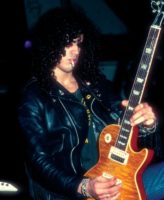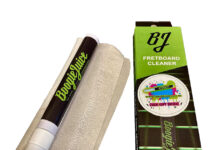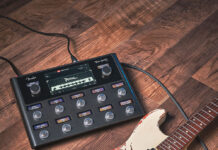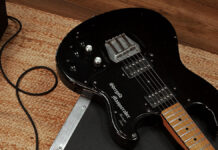
The Secrets Behind Slash's Guitar Sound on GNR's "Welcome to the Jungle"
Finding out what gear guitarists use isn’t a problem. Most players will gladly recite a list of their favorite guitars and equipment when asked, especially if they have signature model products. If they won’t, there’s usually a good chance that somebody somewhere has at least snapped a photo or two of their guitars and live rigs.
The bigger challenge is finding out how most guitarists use their gear. It’s not the fault of guitar journalists or the artists themselves—cataloging every single guitar played and amp or effect setting used can be a tedious, laborious, time-intensive affair, and many guitarists can’t remember all of the details (that’s why they pay their guitar techs big bucks). I personally can’t remember every knob on certain amps I own, let alone what my exact favorite settings are.
To help you figure out how to create the guitar tones of several iconic songs, we’ve dug deep into research mode, combing old interviews and meticulously examining stage and studio photos from the appropriate eras. I then dug into my personal gear collection of over 100 guitars, 75 amps and 400 pedals and rack processors to replicate those sounds. If I didn’t have particular pieces of gear, I used items like Fractal Audio’s Axe-Fx II XL+ and AX8 (extremely helpful), a Line 6 POD HD500X and various iPad apps, including Positive Grid’s Bias Series and IK Multimedia’s AmpliTube Series.
Much of the original gear used to record these songs is well known, and as a result many of these items are very expensive, if you can even find them. For those of you with limited funds, we’ve also put together more affordable alternative rigs that should provide most of the core elements of these tones. If you want it all, the most affordable alternative may actually be Fractal’s AX8 and a great guitar or two of your personal preference.
Because control markings and layout styles are inconsistent, I’ve listed all settings from 0–10 where 0 is completely off, 10 is all the way up and 5 is exactly in the middle. Keep in mind that the sound of even the same guitars and amp models can often vary dramatically, especially with vintage gear more than 30 years old. If the recommended settings don’t sound quite right, tweak them as you see fit. These settings worked best with my rigs and should get you very close, but variables such as a guitar’s tone woods and pickups can make a difference. Pedals are listed in the order that they should be chained together in series from the guitar to the amp.
Also keep in mind that all of the examples are studio recordings, so the sounds may not be ideal for live performance. Other important elements like the mics, outboard gear and mixing console settings used in the studio while tracking, mixing and mastering can affect the overall tone, so these sounds may not completely match the final product you hear on a record. However, we hope you’ll find that our settings get you most of the way there and inspire you to come up with your own signature sounds to influence new generations.
“WELCOME TO THE JUNGLE”
Guns N’ Roses, Appetite for Destruction (1987)
Guitarist: Slash
With its gutter-punk attitude and the raunchiest dual-guitar attack since Aerosmith’s Rocks, “Welcome to the Jungle” was the perfect choice for the first U.S. single release by Guns N’ Roses in 1987.
The song made a potent first impression, mostly thanks to Slash’s dramatic delay-driven intro, massive power chords and blues-infused solos, which made a perfect foil for Axl Rose’s wailing vocals.
Slash’s tone throughout the song comes courtesy of the timeless Les Paul/Marshall combination. While metal guitar tones of the time were all about scooping out the midrange, Slash’s tone is predominantly mids. A Frank Levi–modified Marshall 1959 Super Lead head (#36) rented from L.A.’s Studio Instrument Rentals provided boosted gain crunch and additional midrange honk. For the clean section in the middle, Slash simply rolled down the guitar’s volume control (low/medium-output pickups and a non-master volume amp are key for this approach).
For most of “Jungle” Slash’s tone is bone dry, but on the intro and for a few special “stab” and slide effects, producer Mike Clink employed a favorite secret weapon—the Roland SRV-2000 Digital Reverb. While the SRV offers outstanding reverb effects for guitar, it also can convert into a dedicated digital delay unit by holding down a “secret” control button configuration when powering on, which Clink used for the intro.
The SRV unit plays a crucial role in Slash’s sound throughout Appetite, including the intro to “Sweet Child o’ Mine.”
ORIGINAL GEAR
GUITAR: Mid-Eighties Kris Derrig ’59 Les Paul Standard replica with Seymour Duncan Alnico II Pro humbuckers (bridge pickup)
AMP: 1977 100-watt Marshall Super Lead model 1959 with “Superkill” modification by Frank Levi and Glenn Buckley (Presence: 8, Bass: 5, Middle: 8.5, Treble: 7, Volume 1: 10; guitar plugged into Channel 1 top input)
CABINET: Marshall 1960 4×12 with Celestion Vintage 30 speakers
EFFECTS: Roland SRV-2000 Digital Reverb (set to “secret” delay mode: hold down Reverb/Non Linear, Write and Room Simulate buttons while powering on; Delay Time: 318ms, Feedback: 30, Output: 50)—used on intro only; for “stabs” and slide part increase delay time to 425ms and pair with an additional SRV-2000 in plate A reverb setting.
STRINGS/TUNING: .010–.046 Ernie Ball Slinky/Eb Standard (i.e. tuned down half step to Eb Ab Db Gb Bb Eb)
PICK: Dunlop Tortex 2.0mm
GET THE SOUND, CHEAP!
• Marshall DSL5C combo
• Epiphone Les Paul Traditional PRO-II
• Boss DD-3 Digital Delay
TONE TIP
Place the delay in the Marshall’s effects loop and set the controls for a dotted-eighth note delay, about five-to-six repeats and a 50/50 wet/dry mix for a combination of rhythmic delays and reverb-like decay.
Source: www.guitarworld.com










